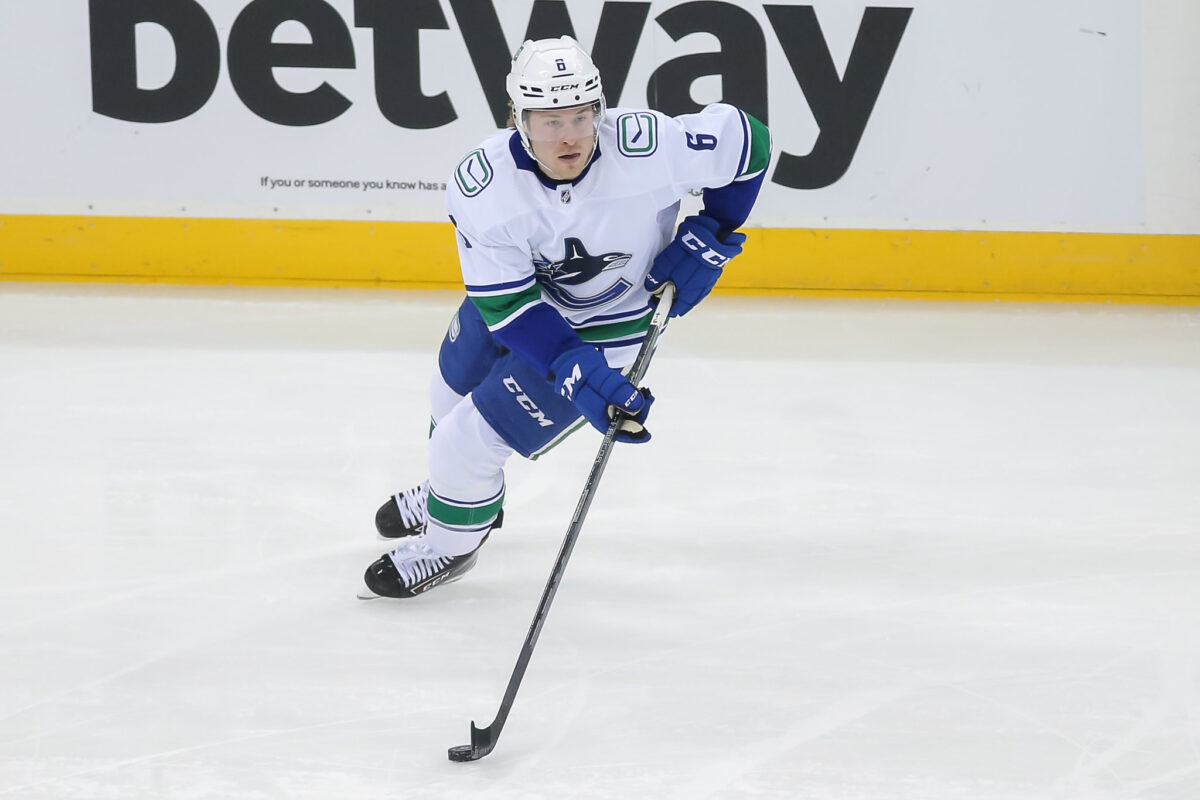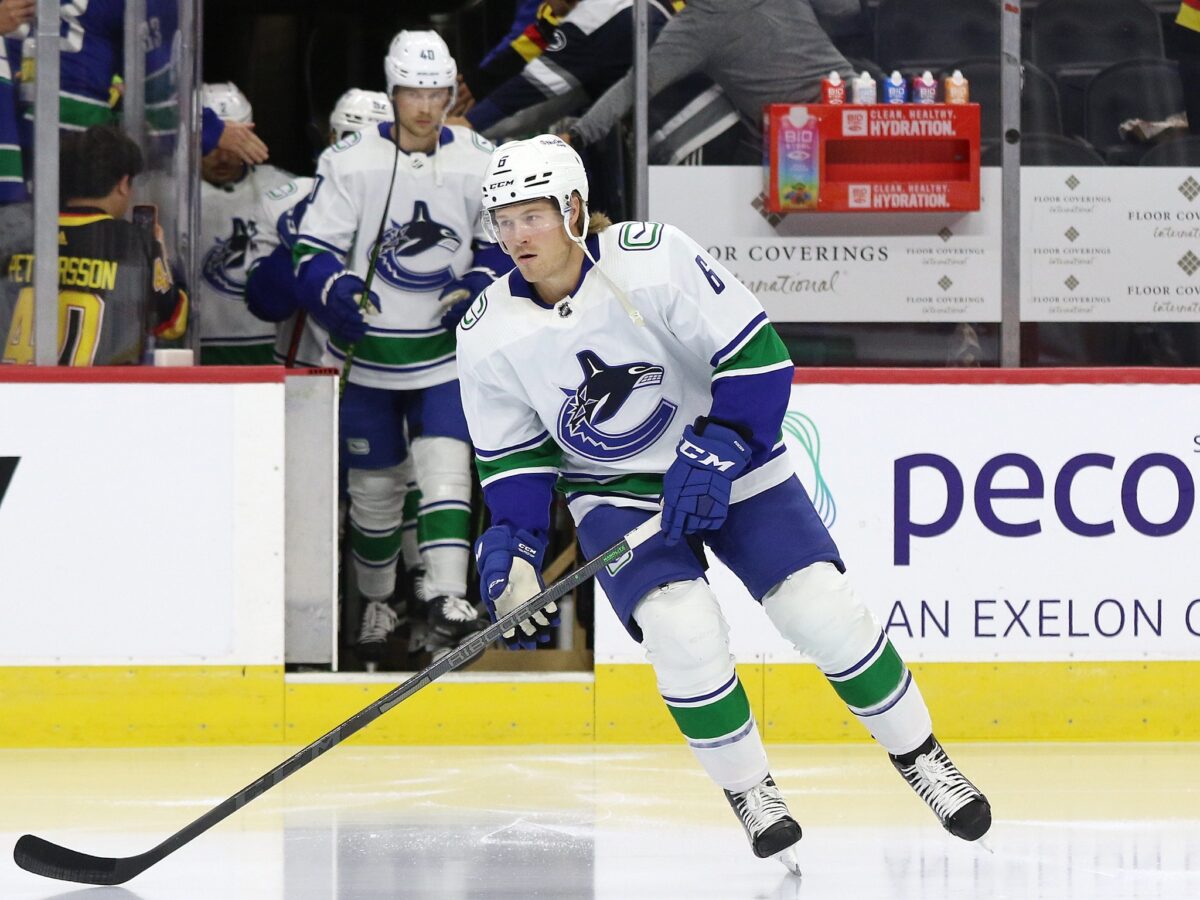Brock Boeser, right winger for the Vancouver Canucks, is available to be acquired via trade, and the Boston Bruins should be interested. The 25-year-old Boeser has an elite shot and has proven to be a very good goal scorer at the NHL level since joining the Canucks in 2017; despite this, however, he’s struggled to put together the same sort of scoring prowess this season as he has in years past.

Part of the reason for Boeser’s decline in production this season may be attributed to a hand injury that he suffered just three days into training camp this season. Another reason may be the fact that he’s playing for a bad team in Vancouver that doesn’t have a lot of good going for them right now. Whatever the reason may be, it doesn’t seem like one irregular season should be the new expected standard for a player like Boeser who has produced four 20-goal seasons already in his career, scoring at a 30-plus goal pace in three of those years.
With the Canucks allowing Boeser to seek a trade and already dealing away captain Bo Horvat to the New York Islanders earlier this year, it’s clear that a full-blown rebuild has begun in Vancouver. Because of this, coupled with the cost to acquire Boeser being relatively low for a player with proven acumen such as his own, it would be strange to see the Bruins shy away from at least inquiring about Boeser.
As Frank Seravalli mentioned, the return for Boeser could be viewed through a few different lenses. If the Canucks simply want to unload Boeser and gain cap freedom, the return, according to Seravalli, could be a draft pick between the second and third-round pick. Seravalli also mentions that most teams view Boeser as being overpaid by roughly $1 million relative to his current production. Boeser, for what it’s worth, is signed to a deal through the 2024-25 season at a $6.65 million cap hit. Should the Canucks retain $1 million or more on his deal, the expected return would have to be more than the return mentioned, but by how much is unknown.
Boeser playing on a cap hit lower than $6 million per season sounds like a good deal. At the same time, it’s not chump change and this must be considered when looking to make a trade; especially when the Bruins only have an estimated $3.25 million in deadline cap space available to them – Boeser would cost them $3.23 million against the cap for the remainder of the season at the time of this writing. Moving salary out to replace the salary coming in may be inevitable at this point. And in the long term, the Bruins must also consider retaining their own players, such as David Pastrnak who remains without a new contract – though the two sides seem financially very close, according to a new report from Emily Kaplan of ESPN.
With the 2023 NHL Trade Deadline right around the corner, the Boston Bruins will be clear buyers as the NHL’s best team on a historic pace. This production has come courtesy of a full team effort, with stellar play from players of every position and tremendous coaching from Jim Montgomery. This type of success hasn’t come simply as a result of talented players, either, as chemistry has played a big role from the very first puck drop of the season.
Related: Boston Bruins 2023 Trade Targets: Philadelphia Flyers
It’s an interesting situation for the Bruins to be in heading into the deadline. While adding talent to this roster and bolstering certain areas or adding depth seems like a wise move on paper, the makeup of this roster and the human aspect of the locker room must be considered.
Bruins Must Consider the Consequences of Trading for Boeser
In acquiring a player like Boeser, the Bruins must consider their own internal roster and lines in the short-term, as well as the long-term. Boeser would likely slot onto the Bruins’ third line alongside Taylor Hall and Charlie Coyle when the team is fully healthy with Jake DeBrusk back in the fold. While DeBrusk would reclaim his spot on the right wing alongside Patrice Bergeron and Brad Marchand, it should be noted that he would still be playing his off-wing. Boeser would immediately become the team’s best goal-scoring right-shot right-winger, setting him up for a solid position with the team in the long term.
This is especially true in the long term with the potential for Pavel Zacha to eventually transition to a top-six center on this team, rather than a winger depending on the futures of Bergeron and David Krejci.
With Boeser on the third line in the short term, Trent Frederic would almost certainly be guaranteed a one-way ticket to the team’s fourth line despite fitting in well alongside Hall and Coyle. While this isn’t necessarily a bad thing, it may cause some regression for Frederic who has taken a step forward this season under Montgomery’s coaching. Still, this may be a worthwhile gamble should Boeser return to form, especially if the deal comes as part of a bigger package that includes defender Luke Schenn.
Boeser’s return to form is no guarantee, of course, especially given the aforementioned hand injury that may or may not still be nagging him. Still, Boeser has still scored nine goals and 30 points in 42 games this season, which would rank Boeser tied for seventh among Bruins’ forward as far as scoring is concerned. It’s also a 17-goal and 58-point pace over 82 games, which isn’t as bad of a year all things considered.

It should also be noted that Taylor Hall’s production was abysmal with the Buffalo Sabres before he was acquired by the Bruins a few seasons ago. Sometimes, a change of scenery and playing with a team that has purpose can go a long way in a player’s on-ice performance. While Boeser and Hall shouldn’t be compared, it’s clear that looks can sometimes be deceiving and capitalizing on low value can be a tremendous victory for a team.
Boeser is still a very good NHL player who can find the soft spots in the offensive zone, has an elite shot and is a solid protector of the puck when he has possession. These are valued traits in the NHL and could make a dangerous Bruins team even more lethal come the postseason; especially given the flexibility it will give them with three capable top-six players skating on their third line when fully healthy.